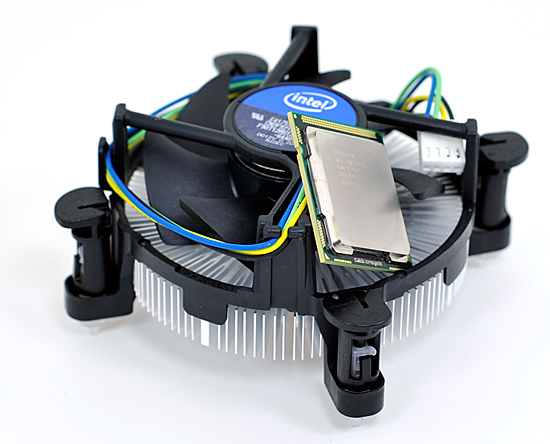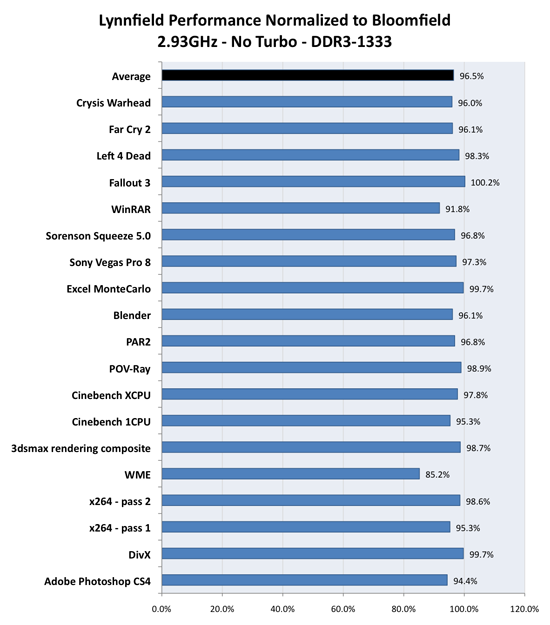The Lynnfield Followup: Turbo Mode and Overclocking Investigated
by Anand Lal Shimpi on September 18, 2009 12:00 AM EST- Posted in
- CPUs
When Lynnfield launched I was on the other side of the country talking GPUs. AMD rented out the USS Hornet to tempt press in and kept them captive for several hours while divulging details of its new DX11 GPUs, the RV770 successors.

Needless to say, while I could read your comments about Lynnfield and what you desired, there was little I could do about it while sitting on (er, in) an aircraft carrier. Gary did a wonderful job with his follow ups but they managed to delay his P55 motherboard reviews. As soon as I landed, it was straight to work on the Lynnfield followup and that's what I'm publishing today.

The first thing many of you asked for were turbo off results between Lynnfield and Bloomfield. On top of that, some wanted results with the exact same memory frequencies. Bloomfield officially only supports up to DDR3-1066, while Lynnfield's memory controller is validated for operation at up to DDR3-1333. Clearly both will work at speeds up to and beyond DDR3-2000, but for stock comparisons I've always tried to stay within validated limits of the platforms.
Below are our application benchmark results comparing Lynnfield to Bloomfield, with turbo disabled, and both platforms running DDR3-1333 at 7-7-7-20 timings. Unlike our standard test beds I've forced the CPUs into their highest performance mode so they are always running at 2.93GHz. The only difference between the two chips is that the Bloomfield is an underclocked Core i7 975 so its un-core runs at 2.66GHz compared to 2.40GHz for the Lynnfield. The real world impact of that difference is negligible:

On average, Lynnfield without turbo mode delivers 96.5% of the performance of Bloomfield. The extra memory controller of Bloomfield is responsible for a 3.5% performance advantage on average; it's just not going to do much at these clock speeds/core configurations.
There are exceptions to the rule. Some applications do benefit from Bloomfield's triple channel memory controller. We see a 15% difference in Windows Media Encoder and nearly a 10% difference in a few other applications. Ultimately it's up to you whether or not the performance difference is worth it, but enable turbo and the advantage clearly goes to Lynnfield as we showed in our initial review.










46 Comments
View All Comments
CloudFire - Saturday, September 19, 2009 - link
Actually, you're the one that's a bit confused here.If you are using Turbo mode, you do not consume more power. The chip has a TDP of 95w, and it will not exceed that under all conditions. If you are running 4 cores, then it will even distribute the power to all the cores staying at 95w.
If you are running turbo, 2 of 3 of the cores shut off, and the remaining 1 core runs at a faster speed b/c all the juice is being used in that core, all the while staying at 95w TDP.
The difference in "Turbo" and overclocking is that, Turbo stays at TDP while overclocking goes over TDP.
the zorro - Saturday, September 19, 2009 - link
that's completely wrong.turbo is just overclocking you don't have to be a rocket scientist to understand this.flipmode - Sunday, September 20, 2009 - link
Turbo is not overclocking. You clearly are a noob, or you would know what overclocking means. Here, I'll educate you: Overclocking: verb: running a computer component, such as a CPU, beyond its factory set specifications.Since Turbo is a FEATURE, and is a part of the specification of the chip, it is in no way overclocking.
MamiyaOtaru - Sunday, September 20, 2009 - link
haha lookit how wrong you are. The whole point of turbo mode is when you have something like a single threaded app that is only going to use one core. No need to have all four chugging along then is there? So three of them shut off, and the core doing the work is overclocked to take advantage of the added headroom created when the other three shut off. No more power than all four of them running at normal speed.If all four cores are working away on something, turbo mode doesn't kick in. Simple as that, but it apparently does require a rocket scientist (aka not you)
silverblue - Sunday, September 20, 2009 - link
There is actually one speed bin for all four cores (same for three).AssBall - Saturday, September 19, 2009 - link
Maybe you should actualy read some of the lynnefield articles, not all four cores are overclocked in turbo mode, sweet-tits.